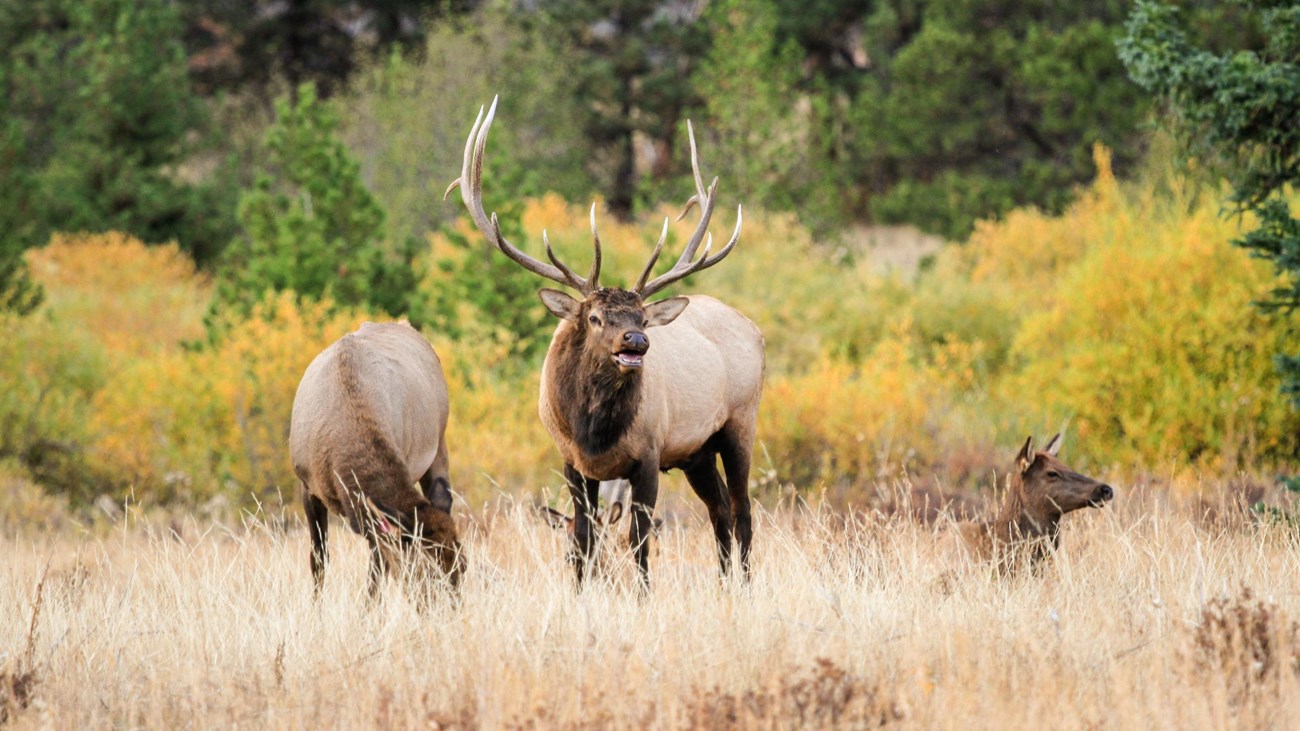Last updated: October 10, 2024
Thing to Do
Wildlife Viewing in RMNP

NPS
Wildlife Viewing Tips
Rocky Mountain National Park is home to an incredible range of wildlife, including over 60 species of mammals, 280 species of birds, 6 species of amphibians, 1 reptile, 11 species of fish, and 142 confirmed species of butterflies.
Some basic knowledge of animal habits and habitats greatly enhances prospects of spotting Rocky Mountain's wild residents. A few to keep an eye out for:
- Elk can be seen anytime. The fall rut season, or mating season, is one of the most popular times of year to view elk. Look for elk in meadows and where meadow and forest meet. Elk spend much of their time at or above treeline during the summer, moving to lower elevations in the fall, winter and spring. Favorite feeding times: dawn and dusk.
- Bighorn sheep are commonly seen at Sheep Lakes from May through mid-August.
- Mule deer are common and can be seen anywhere. They are most often found at lower elevations in open areas.
- Bats feed over lakes and ponds at dawn and dusk.
- Yellow-belied marmots and pikas favor rocky areas. Marmots are best seen on the alpine tundra along Trail Ridge and Old Fall River roads. Pikas - small, light-colored mammals - are common in rock piles. Listen for their sharp, distinctive bark and watch for movement.
- Clark's nutcrackers, Steller's jays, golden eagles and prairie falcons can be seen along Trail Ridge Road.
- White-tailed ptarmigans, some of the most sought-after birds in Rocky Mountain National Park, are common but difficult to spot. For best results, hike on the tundra and look carefully. Ptarmigans usually remain still, relying on their natural camouflage for protection.
- American dippers, or water ouzels, can be found along most streams. Listen for their loud call, similar to the rapid clicking of two stones together, as they fly up and down their territories.
Help Protect Wildlife - Don't Feed Them!
Feeding human food to wildlife, even fruit and nuts, reduces the animal's natural ability to survive. Animals that learn to associate humans with food are then attracted to vehicles and roads, making them easy prey to automobiles.
As wildlife become habituated to humans, they also lose their natural fear of humans and they can become aggressive in their quest for food.
It is illegal to feed, approach, and/or harass wildlife in all national parks.
Wildlife Photography Tips
When you spot wildlife, getting a great photo or video from the safe distance isn’t too hard if you follow our advice. Although mobile device cameras are convenient, you may want to bring along a camera that has a long zoom lens for better zoomed-in photos.
For most wildlife in the park, including deer, bighorn sheep, and elk, keep back at least 75 feet, or two bus-lengths. When viewing bears, moose, and mountain lions, we recommend staying back at least 120 feet, or three bus-lengths.
If an animal reacts to you, you are too close! If an animal comes closer to you, it is your responsibility to move back and give them plenty of space.
Pets are prohibited on ALL Rocky Mountain National Park trails, tundra, and meadows.
Where Pets Can Go
Leashed pets may accompany you only in the following areas:
- Along established roads or in parking areas
- In established campgrounds and picnic areas
Pets must be kept on leashes no longer than six feet. Pets may not make noise that impacts visitors or wildlife. Pet owners must pick up and dispose of pet excrement in trash receptacles.
Park entrance fees are required 24 hours per day, 7 days per week.
There are great wildlife viewing opportunites throughout Rocky Mountain National Park.
